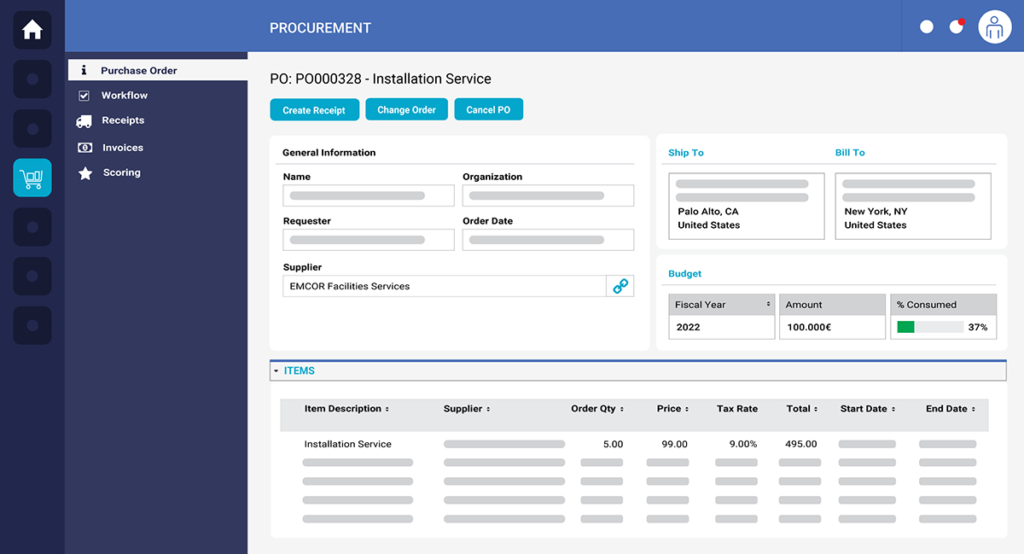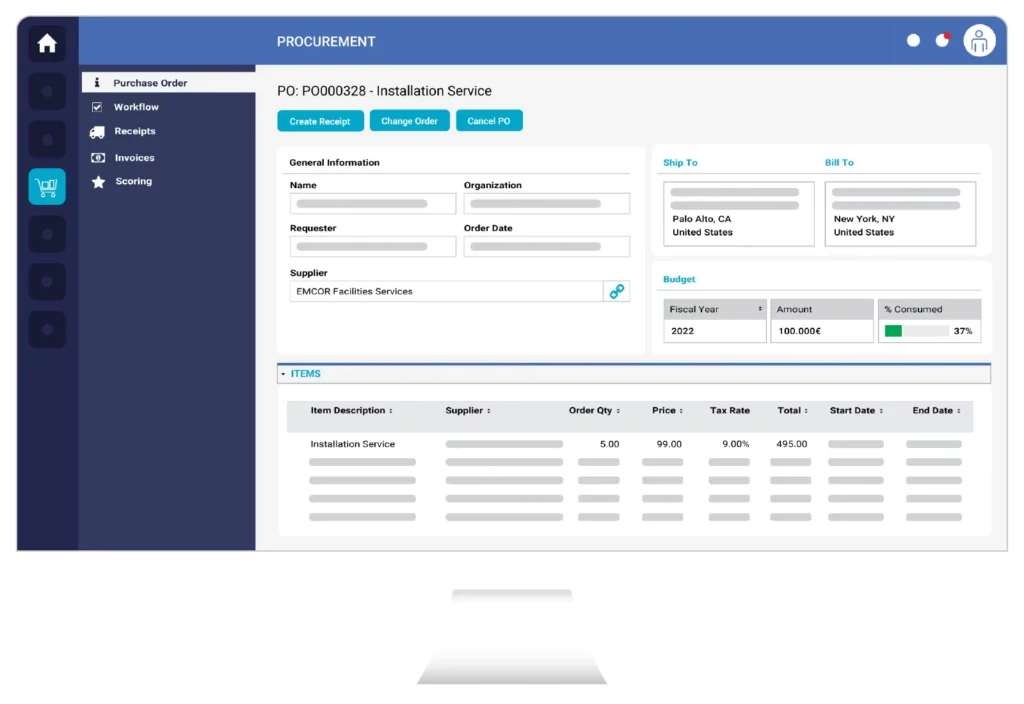Managing purchases might seem simple – until your team is juggling dozens of vendors, tracking approvals across departments, and trying to avoid costly mistakes. If that sounds familiar, you’re likely looking to bring order to the chaos.
Whether you’re refining your procurement process or building one from scratch, understanding purchase order management is a critical step.
In this blog, we take an in-depth look at Purchase Order (PO) management, why it matters, and how it can help you streamline operations, reduce risk, and improve supplier relationships. We also share actionable best practices to help make your PO process more efficient and scalable.
Key Takeaways
- Effective purchase order management is essential for cost control, reducing risk, and aligning procurement with finance.
- Enterprise-grade PO systems must support PO process automation, visibility, and integration across the full source-to-pay process.
- Choosing the right Procure-to-Pay software can improve compliance, streamline operations, and drive faster time-to-value.
| Discover how to streamline purchase order management and boost efficiency with Ivalua. Find Out More |
What Is Purchase Order Management?
Purchase order management is the process of creating, tracking, and managing purchase orders (POs) to ensure goods and services are ordered, received, and paid for correctly.
In complex organizations, this process plays a crucial role in maintaining control over spend, meeting compliance requirements, and maintaining visibility across procurement and finance functions.
A well-managed PO process helps prevent overspending while strengthening supplier relationships. It also improves the accuracy of budget tracking and forecasting. Purchase order management software is essential for enabling this process at scale.
How Is Purchase Order Management Different from Procurement?
Purchase order (PO) management and procurement serve distinct but connected roles within an organization.
Procurement refers to the broader strategic sourcing and acquiring of goods and services, which involves identifying needs and evaluating suppliers to negotiate contracts.
PO management focuses on the tactical execution: issuing, tracking, and managing POs to ensure compliance and accuracy throughout the Procure-to-Pay lifecycle.
The table below summarizes the key ways in which procurement and PO management differ:
| Procurement | PO Management | |
| Scope | Covers the end-to-end sourcing process. | Handles the creation, approval, and monitoring of purchase orders. |
| Objective | Aims to secure value and mitigate supplier risk. | Enforces spend control, budget alignment, and policy compliance. |
| System Touchpoints | Often integrates with sourcing and contract management tools. | Must connect tightly with finance systems, ERP, and supplier portals. |
Why Purchase Order Management Matters In Enterprise Procurement
In enterprise environments, effective PO management can be a strategic enabler, helping to control spend and hold suppliers accountable.
On the flipside, when PO management is fragmented or manual, organizations face real risks. Even small inefficiencies or inconsistencies in PO processes can create significant downstream issues:
- Mismatched Invoices: Without properly issued and tracked POs, invoice data often doesn’t align with approved purchases, leading to payment delays, supplier disputes, and increased processing time.
- Unapproved Spend: Purchases made outside the PO process (so-called “maverick spend”) erode budget visibility and compliance, making it difficult to enforce policies or forecast costs accurately.
- Audit and Compliance Exposure: Lack of traceability or inconsistent documentation puts you at risk during audits, especially when controls around purchase approval, contract alignment, or supplier terms are unclear.
In contrast, a well-managed PO process creates a clear digital trail from requisition to payment, enabling proactive spend oversight. You can track supplier performance and reduce financial leakage, as well.
The 7 Steps Of A Standard Purchase Order Management Lifecycle
While the specifics may vary by company or system, the typical PO management process includes the following seven steps:
- Identify a Need: A department or stakeholder recognizes the need for goods or services, triggering the procurement process.
- Submit a Purchase Request (PR): A formal request is submitted for review – typically through a purchase requisition or request-for-purchase (RFP) workflow – to validate the need and secure internal approval.
- Select Vendors: Procurement evaluates and selects the most suitable vendor or vendors, considering factors like price, quality, availability, and supplier history.
- Negotiate Terms and Issue a PO: Procurement determines key terms such as pricing, delivery schedules, and payment conditions which must be finalized before issuing a PO.
- Create and Approve the PO: Procurement generates a detailed PO in the system and routes it for internal approval based on spend thresholds and department policies.
- Receive and Inspect the Shipment: Once the goods or services are delivered, teams verify receipt and inspect quality to ensure alignment with the original PO.
- Close the PO: After confirming that the delivery matches the PO and invoice, the transaction is closed in the system, supporting three-way matching and accurate financial reporting.
A modern, automated PO process ensures each of these steps is executed efficiently, with real-time visibility and audit-ready documentation.

Key Challenges Large Teams Face with Purchase Orders
In complex enterprises, managing POs at scale can introduce friction that hinders operational efficiency and supplier management. Here are five critical challenges that often arise.
Disconnected PO and Invoice Workflows
When purchase orders and invoices are managed in siloed systems, mismatches and errors are inevitable. Without a fully integrated Procure-to-Pay process, teams struggle to reconcile documents. Payments can be delayed, as well, leading to supplier disputes.
Lack of Real-Time Budget Visibility
Procurement and finance teams need timely, accurate data to make informed decisions. Without access to real-time spend analytics, it’s difficult to track committed spend, monitor budgets, or proactively manage cost overruns.
Manual Approvals and Delays
Manual PO routing during the approval process is time-consuming and error-prone. As PO volumes increase, these delays disrupt procurement timelines and reduce agility. A seamless Procure-to-Pay flow can eliminate bottlenecks and accelerate purchasing.
No Audit Trail Across Sourcing, PO, and Payment
Disconnected systems make it nearly impossible to maintain a clear, end-to-end record of procurement activities. Without a unified Source-to-Pay platform, audit preparation becomes a painful process riddled with inconsistencies.
Supplier Confusion and Order Fulfillment Errors
When suppliers receive incomplete or outdated order information, delays and fulfillment issues follow. A lack of alignment on direct spend management can introduce supply chain risk and reduce overall supplier satisfaction.
| Download our Procure-to-Pay (P2P) Transformation Checklist to identify process gaps and accelerate your digital procurement journey. |
Core Features of an Enterprise-Ready PO Management System
To handle scale, compliance, and complexity, organizations need a fully integrated purchasing software solution. Below, we outline the essential features every enterprise-ready e-procurement platform should include, along with real world examples of how organizations using Ivalua’s purchase order software can leverage these features in real-world scenarios.
Automated PO Creation and Approval Workflows
Manual PO creation can introduce delays and errors, slowing down the procurement process and increasing cycle times. Ivalua streamlines this process with configurable, automated workflows that align with your organization’s procurement automation policies.
These workflows ensure POs are generated, reviewed, and approved based on procurement software best practices, accelerating processing while helping you maintain control.
Real-time PO Tracking and Spend Visibility
Without centralized visibility, organizations risk overspending and poor vendor performance. Ivalua enables real-time tracking of POs, giving you instant insight into order status, fulfillment timelines, and spend against budget.
With full visibility into spend, proactive decision-making and effective spend analysis become possible, and you can make sure finance and procurement teams are always aligned.
Three-way Matching for PO, Invoice, and Receipt
Errors in invoice matching can lead to delayed payments, overpayments, and compliance issues. Ivalua’s Source-to-Pay process includes built-in 3-way matching to reconcile POs, goods receipts, and invoices automatically. This reduces exceptions and enhances financial accuracy, ensuring your team is always audit-ready.
Budget Enforcement and Role-based Thresholds
Without strong intake management, teams may commit to unbudgeted spend or make purchases outside their approval authority. Ivalua’s configurable budget controls and role-based thresholds help you govern who can approve what – and under what condition – improving financial discipline and alignment with budget owners.
Integration with ERP, Sourcing, and Supplier Systems
Disconnected tools create bottlenecks, lead to duplicate data, and impact visibility. Ivalua’s Source-to-Pay platform integrates seamlessly with ERP systems, sourcing workflows, and supplier portals to provide end-to-end process continuity and complete visibility, breaking down silos.
Centralized PO Audit Trail and Compliance Logging
Maintaining a full audit trail is essential for regulatory compliance and internal oversight, especially in larger enterprises. Ivalua supports procurement software best practices with centralized, tamper-proof audit logs of every PO action from creation to close, ensuring transparency and accountability for faster, easier audits.

| Download the Procure-to-Pay Data Sheet to see how Ivalua streamlines the entire P2P process while improving compliance enforcement, spend visibility, and supplier collaboration. |
Customer Story: How Maxim Accelerated Supplier Enablement &
Invoice Automation
Maxim faced several persistent challenges with its previous Procure-to-Pay system. For instance, only 15 suppliers had been onboarded in over seven years. The legacy platform’s complexity, slow performance, and poor user interface resulted in a lot of manual, paper-based processes that discouraged supplier adoption and hindered the PO process.
Ivalua’s flexible, user-friendly platform not only streamlined procurement but also drove supplier engagement at scale. In just eight weeks, they:
- Enabled over 1,100 internal users
- Made 2,162 catalog items accessible
- Launched 10 hosted supplier catalogs
“Our users went right into the system with only a few training guides … We have more control and flexibility than we had before. We were able to make our own updates without support or additional services.”
– Cindy Seabrease Director of Purchasing and Accounts Payable Maxim Healthcare
Read the full Maxim case study.
What to Look for in a Purchase Order Management Platform
As organizations grow, so do the complexities of managing spend, suppliers, and approvals. The right purchase order management platform helps to connect procurement with finance and enforce policy without creating friction.
To achieve this, you need a system that provides the following key capabilities:
- Automated PO Workflows: Streamlines the creation, approval, and routing of purchase orders to eliminate manual effort and reduce errors.
- Seamless Source-to-Pay Integration: Ensures the platform connects with sourcing, contract management, invoicing, and payment systems for end-to-end visibility and control.
- Real-Time Budget Visibility: Enables proactive spend management by providing up-to-date insights into budget consumption and remaining funds.
- Supplier Performance Tracking: Monitors supplier fulfillment rates, delivery timelines, and compliance metrics to strengthen supplier relationships and ensure accountability.
- Configurable Approval Rules: Supports role-based and threshold-based automated approvals to enforce internal policies and maintain financial governance.
- ERP and Finance System Connectivity: Integrates tightly with existing ERP, accounting, and finance tools to keep data consistent and eliminate reconciliation delays.
- Audit-Ready Documentation: Maintains a complete and searchable audit trail of every purchase order, change, and approval for compliance and reporting.
Ivalua’s Procure-to-Pay software delivers these capabilities through a unified, user-friendly interface.
To learn more about how Ivalua’s procure-to-pay software can streamline your PO management and drive measurable results, explore our procurement platform or get in touch to start your transformation.
| See how Ivalua simplifies purchase order management. Watch Demo / Find Out More |
FAQs about Purchase Order Management
What’s the role of PO matching in preventing payment errors?
PO matching ensures that invoices and receipts align with approved purchase orders before payment is made. This three-way match helps prevent overpayments, duplicate payments, and billing for undelivered goods.
What’s the link between POs and invoice fraud prevention?
Purchase orders create a structured approval trail that helps verify legitimate spend. Requiring a valid PO before payment adds a layer of control that deters fraudulent or unauthorized invoices.
How does PO management connect to ERP and finance systems?
A purchase order management system integrates with ERP and finance platforms to sync budget data, track spend, and streamline approvals. This ensures financial accuracy and enables real-time visibility into commitments and cash flow.
Further Reading
Procurement vs Purchasing: Key Differences, Workflows, and Enterprise Risks
Purchase Orders Explained: Types, Process, & Technology
Purchase-to-Pay (P2P): Definition, Process, Benefits & Insights



